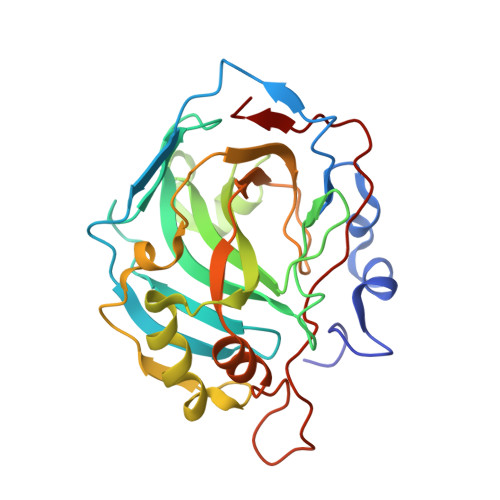Structure and mechanism of copper-carbonic anhydrase II: a nitrite reductase.
Andring, J.T., Kim, C.U., McKenna, R.(2020) IUCrJ 7: 287-293
- PubMed: 32148856
- DOI: https://doi.org/10.1107/S2052252520000986
- Primary Citation of Related Structures:
6PDV, 6PEA - PubMed Abstract:
Nitric oxide (NO) promotes vasodilation through the activation of guanylate cyclase, resulting in the relaxation of the smooth muscle vasculature and a subsequent decrease in blood pressure. Therefore, its regulation is of interest for the treatment and prevention of heart disease. An example is pulmonary hypertension which is treated by targeting this NO/vasodilation pathway. In bacteria, plants and fungi, nitrite (NO 2 - ) is utilized as a source of NO through enzymes known as nitrite reductases. These enzymes reduce NO 2 - to NO through a catalytic metal ion, often copper. Recently, several studies have shown nitrite reductase activity of mammalian carbonic anhydrase II (CAII), yet the molecular basis for this activity is unknown. Here we report the crystal structure of copper-bound human CAII (Cu-CAII) in complex with NO 2 - at 1.2 Å resolution. The structure exhibits Type 1 (T-1) and 2 (T-2) copper centers, analogous to bacterial nitrite reductases, both required for catalysis. The copper-substituted CAII active site is penta-coordinated with a 'side-on' bound NO 2 - , resembling a T-2 center. At the N terminus, several residues that are normally disordered form a porphyrin ring-like configuration surrounding a second copper, acting as a T-1 center. A structural comparison with both apo- (without metal) and zinc-bound CAII (Zn-CAII) provides a mechanistic picture of how, in the presence of copper, CAII, with minimal conformational changes, can function as a nitrite reductase.
Organizational Affiliation:
Department of Biochemistry and Molecular Biology, College of Medicine, University of Florida, Gainesville, FL 32610 USA.

















